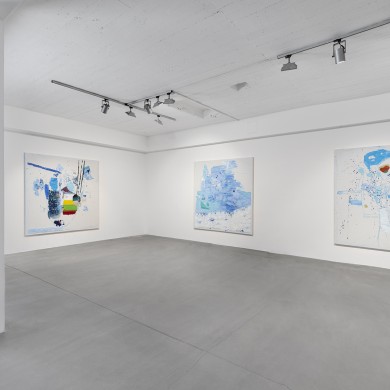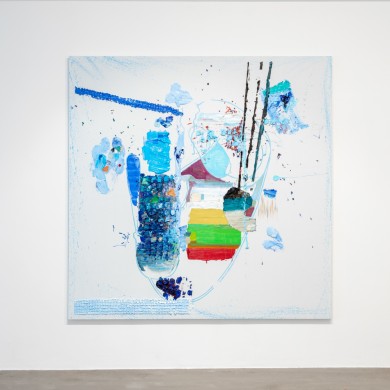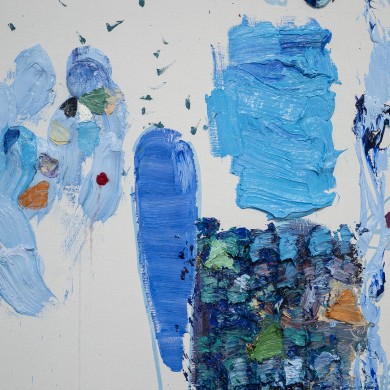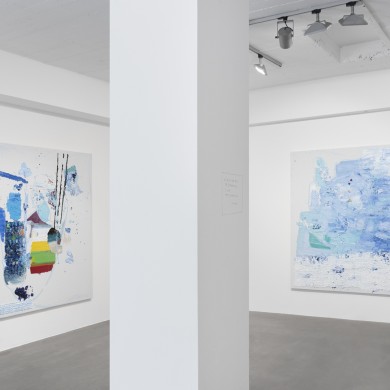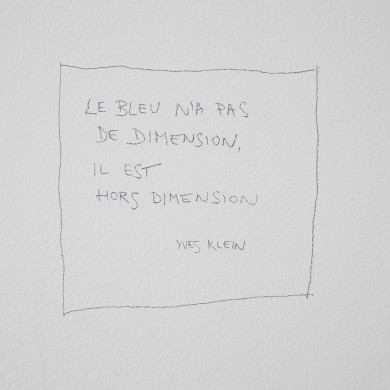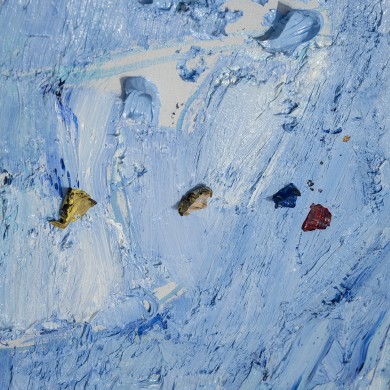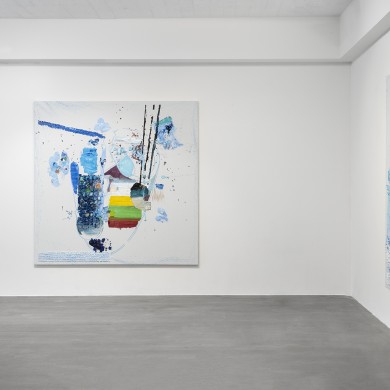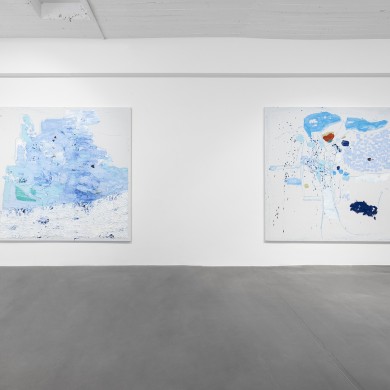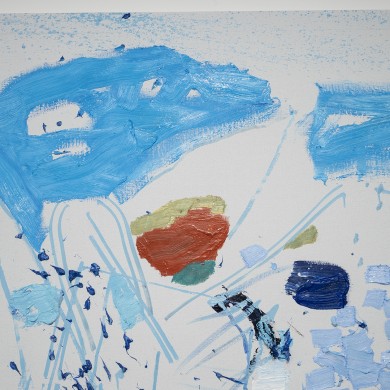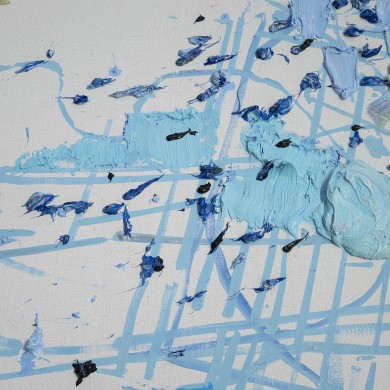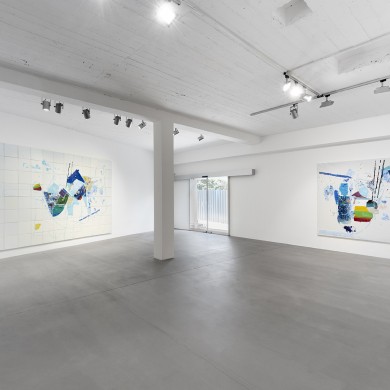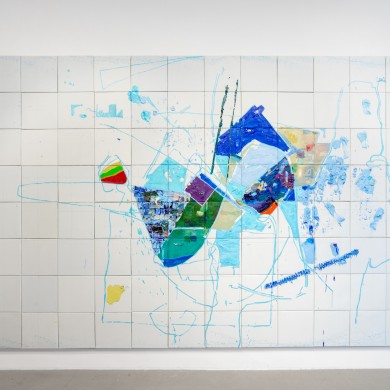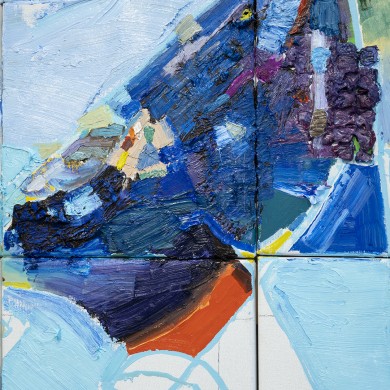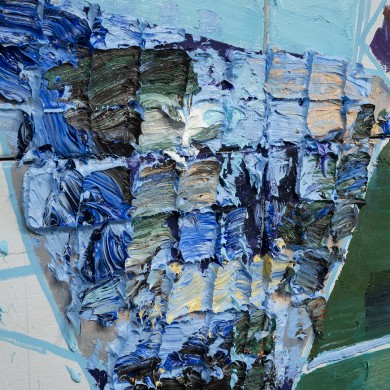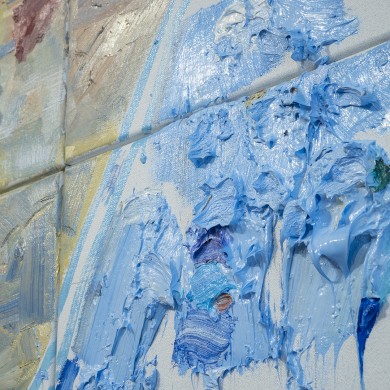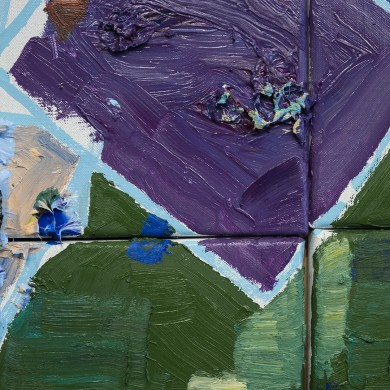Juraj Kollár | Composition of Blue
curator: Silvia Van Espen
5 May – 30 June 2023
ZAHORIAN & VAN ESPEN Bratislava
ZAHORIAN & VAN ESPEN Gallery presents Juraj Kollár’s sixth solo exhibition.
Juraj Kollár (1981) is an artist who unceasingly astonishes, with his truthful approach to art and his unflinching determination to discover. Constantly he explores those fundamental elements that first led him to painting: colours and forms. Via his paintings, Kollár challenges the viewer to look beyond the boundaries of what he/she sees on the surface. This artist is seeking not direct routes or literal portrayals, but rather a visual expression of the complexity of thoughts and emotions.
The current series of paintings consists of remarkable large-format canvases full of whirling blue brushstrokes, which evoke the vastness of the ocean or the endlessness of the sky. They have an almost hypnotic effect, drawing us into their depth and arousing a feeling we might have if we were floating among waves. Kollár has long drawn inspiration from Nature (Morning Landscape, 2006; Morning Beach, 2016), and often from the sky’s endless expanse. Sky (2016) is a unique mixture of abstract expressionism and minimalism.
Blue is among the colours that (throughout history) have overwhelmed artists and viewers. It is the colour of the clear everyday sky, the dense layer of water, and everything between those two. For Kollár, working with it is nothing novel. Let us recall 101009 from as far back as 2009, or a series of abstractions during the years 2016 -18 (e.g. 010517, 250518); furthermore, Blue Tops (2012), Street (2016), and Surface (2018). The colour blue represents, for Kollár, an essence of the identity, memory and experience that he takes on by his creative journey in art. With his acute sense of colour, he thus interweaves his work with its diverse hues and depths, which always seem to draw the viewer into another world.
Juraj Kollár continues. He experiments, and incessantly pushes outwards the boundaries of the possible. An identifiable symbol of his journey is the grid, the square as a signature, as the wink of an eye. Basic shape as the core of a composition that communicates a feeling of energy and motion. All of the works at the exhibition are in square format: “The square does not dictate a feeling of spatial orientation for the abstract work; it is more neutral. We do not seek what is up or down, the whole thing is objective, and I work with squares continually… The composition has a central scope, a segment of reality…”
Although his current work is distinguished (at first glance) by abstract qualities, the paintings nonetheless have a certain realism, hinting at connection with the physical world: “I paint clouds, and minimalistic actions play out in the sky and enter the clouds, which are organic, and at the same time radical, industrial structures enter the painting (barbed wires appear there, or various flying machines, which create a mechanical structure, and there’s that organic (structure) in motion, the clouds are that… The concrete is the mutability of abstraction… I like that ambivalence: it has the quality of portraying something concrete, but in reality things are not so.” In Juraj Kollár’s sky the spiritual and material have an encounter. Dream and fragments of childhood flow alongside the corpus delicti of industrialisation of the countryside.
The title of the exhibition, Composition of Blue, evokes Composition with Blue (1937) by Piet Modrian (1872 Netherlands – 1944 USA). Radical simplification of the composition, reduction of colours and grids: those are basic elements for one of the pioneers of abstract painting, which is the essence of Kollár’s work also. Kollar’s skies, like Cloud Paintings by Tala Madani (1981, Teheran), portray an analogous formation of clouds and their movement through the sky. On examining them more closely, “interiorities” of the painting that escape a first viewing become manifest, for example children’s toys, figures, structures. Each of these artists naturally approaches the work of allocation from a completely different standpoint. Both of them, contemporaries in their age-group (Madani and Kollár) invite the viewer to open up to what we ordinarily try to suppress or sublimate — and raise our eyes to the sky. Viewing it, contemplating it, one breathes a breath of freedom.
Supported using public funding by Slovak Arts Council ![]()
Galéria ZAHORIAN & VAN ESPEN predstavuje šiestu samostatnú výstavu Juraja Kollára.
Juraj Kollár (1981) je umelcom, ktorý neprestáva uchvacovať svojím pravdivým prístupom k tvorbe a neochvejným odhodlaním objavovať. A to pri neustálom skúmaní základných elementov, ktoré ho prvýkrát priviedli k maľbe: farby a formy. Kollár prostredníctvom svojich obrazov vyzýva diváka, aby sa pozeral za hranice toho, čo vidí na povrchu. Nehľadá priamočiare či doslovné zobrazenia, ale vizuálne vyjadrenie komplexnosti myšlienok a emócií.
Aktuálnu sériu obrazov tvoria pozoruhodné veľkorozmerné plátna plné víriacich modrých ťahov štetca, ktoré evokujú rozľahlosť oceánov alebo nekonečnosť oblohy. Majú až takmer hypnotický účinok, vťahujú nás do hĺbky a vyvolávajú pocit, akoby sme sa vznášali medzi vlnami. Kollár dlhodobo čerpá inšpiráciu z prírody (Morning Landscape, 2006. Morning Beach, 2016), neraz z nekonečnej rozlohy neba – Sky (2016) je jedinečnou zmesou abstraktného expresionizmu a minimalizmu.
Modrá patrí medzi farby, ktoré si (počas histórie) výnimočne podmaňovali umelcov aj divákov. Je to farba jasnej dennej oblohy, hrubej vrstvy vody a všetko medzi tým. Pre Kollára nie je práca s modrou novinkou. Spomeňme dielo 101009 už z roku 2009, či sériu abstrakcií v rokoch 2016 – 2018 (napr. 010517, 250518), ďalej Blue Tops (2012), Street (2016) alebo Surface (2018). Modrá predstavuje pre Kollára esenciu identity, pamäti a skúseností nadobúdanými cestou svojej umeleckej tvorby. S bystrým citom pre farbu tak pretkáva svoju prácu jej rôznymi odtieňmi a hĺbkami, ktoré akoby diváka vždy vťahovali do iného sveta.
Juraj Kollár pokračuje. Experimentuje a neustále posúva hranice možného. Rozpoznateľným znakom jeho cesty je raster, štvorec ako podpis, ako žmurknutie oka. Základný tvar ako jadro kompozície, ktorá sprostredkováva pocit energie a pohybu. Všetky diela na výstave sú vo štvorcovom formáte: „Štvorec neudáva abstrakcii pocit priestorovej orientácie, je neutrálnejší. Nehľadáme, čo je hore či dole, celé je to objektívne a so štvorcami pracujem kontinuálne… Kompozícia má centrálny záber, výsek z reality…“
Napriek tomu, že na prvý pohľad sa aktuálne dielo vyznačuje abstraktnými vlastnosťami, majú obrazy určitý realizmus, ktorý naznačujú spojenie s fyzickým svetom: „Maľujem oblaky a na oblohe sa odohrávajú minimalistické deje, ktoré vstupujú do oblakov, ktoré sú organické, a zároveň do obrazu vstupujú radikálne industriálne štruktúry (objavujú sa tam drôty alebo rôzne lietajúce stroje, ktoré vytvárajú mechanickú štruktúru, a tá organická (štruktúra) v pohybe, tou sú oblaky… Konkrétno je premenlivosť abstrakcie… Páči sa mi tá ambivalencia: má to vlastnosť zobrazovať niečo konkrétne, ale v skutočnosti to tak nie je.“ Na oblohe Juraja Kollára sa stretáva duchovno a materiálno. Sen a fragmenty detstva plynú povedľa corpus delicti industrializácie krajiny.
Názov výstavy Composition of Blue odkazuje na dielo Composition with Blue (1937) od Pieta Mondriana (1872 Holandsko – 1944 USA). Radikálne zjednodušenie kompozície, redukcia farieb a raster, základné prvky jedného z priekopníkov abstraktného maliarstva, ktoré sú esenciou aj Kollárovej tvorby. Kollárove oblaky, rovnako ako Cloud Paintings od Taly Madani (1981, Teherán) zobrazujú analogickú formáciu oblakov a ich pohybu po oblohe. Pri bližšom skúmaní sa vyjavujú prvému pohľadu unikajúce „vnútornosti“ obrazu, napr. detské hračky, postavy, štruktúry. Každý z autorov prirodzene pristupuje k svojmu posolstvu z úplne inej strany. Obaja rovesníci (Tala Madani aj Juraj Kollár) pozývajú diváka otvoriť sa tomu, čo sa bežne snažíme potlačiť alebo sublimovať… a pozdvihnúť oči k oblohe. Pohľad na ňu, jej kontemplácia, nesie v sebe nádych slobody.
